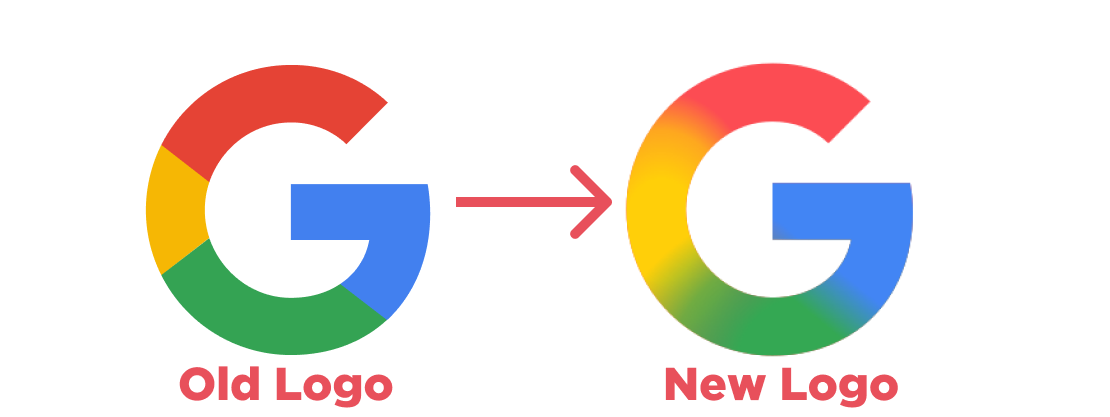
Google just updated its logo, and while the change might seem minor at first glance, it hints at something much bigger. The new look closely mirrors the branding of Gemini, Google’s AI platform, signaling a quiet but strategic shift toward aligning with its future in artificial intelligence. Google hasn’t confirmed the connection outright, but the visual cues are loud enough.
What this shows is simple but powerful: no brand, not even one of the biggest in the world, is above revisiting its identity. A brand refresh isn’t just for outdated logos or companies trying to recover relevance. It’s a smart, proactive way to stay aligned with where your industry is going — before you’re forced to.
In this blog, we’re breaking down how even the smallest design tweaks can shape public perception, hint at innovation, and set the tone for what’s next. And more importantly, we’ll look at what eCommerce brands can learn from Google’s subtle but strategic logo shift.
Subtle Changes, Major Impact
At first glance, Google’s updated logo looks almost identical to the old one, but look closer. The proportions are tighter, the letterforms feel more balanced, and there’s a slight shift in weight that brings it visually closer to the branding of Gemini, Google’s AI platform. It’s a small move, but one with clear intent.
 Google’s Logo Change
Google’s Logo Change
These kinds of micro-adjustments are more than just aesthetic clean-up. They’re signals, to users, investors, and the industry, that a brand is evolving. When done right, subtle changes like these help brands modernize without losing their core identity. They reinforce familiarity while introducing something new, which is exactly how you maintain trust during a transition.
For eCommerce brands, the takeaway is clear: you don’t need a total overhaul to stay current. Sometimes, all it takes is refining the details, typography, spacing, color balance, to better reflect where your brand is going. Consistency breeds recognition, but evolution is what keeps you relevant.
The Power of Future-Proofing
Google’s updated logo doesn’t exist in a vacuum, it clearly nods to the design language of Gemini, its AI platform. This alignment isn’t accidental. It’s a visual cue that the company is embracing an AI-first future, not just in technology, but in brand expression. Even without an official announcement, the message is clear: Google is evolving, and its identity is evolving with it.
This kind of future-proofing matters. In today’s landscape, standing still is the fastest way to fall behind. Tech, design, and consumer behavior move fast, and your brand has to move with them. Waiting until things feel “outdated” is a reactive strategy. Smart brands, like Google, adapt early and often, so they’re always positioned for what’s next.
For eCommerce businesses, this lesson hits close to home. Your customers expect a seamless, forward-thinking experience — fast mobile performance, AI-powered support, real-time recommendations, and modern, intuitive design. If your brand visuals or site UX feel stuck in the past, it creates friction. And friction costs you sales.
Future-proofing isn’t about chasing trends, it’s about making sure your brand stays aligned with how people shop, think, and engage now and next. Google’s doing it. So should you.
You’re Never Too Big for a Brand Refresh
Google’s logo update is a reminder that even the most established brands in the world still take the time to re-evaluate how they show up. And not because anything is broken. The update wasn’t a fix, it was a signal. A shift. A reminder that staying relevant requires intention.
This is where a lot of businesses get it wrong. They wait until something feels off — declining user engagement, dated visuals, lost conversions — before taking a hard look at their brand identity. But by the time those signs show up, it’s already overdue. The smarter approach? Regular brand marketing audits. Checking in before things feel stale. Asking questions like: Does our branding still match who we are? Is it aligned with where we’re headed?
Take Budget Heating & Air Conditioning Inc. as an example. They’ve been around since 1994, an stablished name in their space. But that didn’t stop them from embracing a fresh direction. As part of their website redesign, we introduced a subtle but powerful logo animation: a spinning fan element that comes to life when you enter the site. It’s a small touch, but it signals motion, energy, and relevance, all while staying true to the brand’s identity. This kind of evolution doesn’t erase history; it honors it while keeping the experience modern and engaging.
 BudgetHeating.com Logo Refresh – Old (Top), New (Bottom)
BudgetHeating.com Logo Refresh – Old (Top), New (Bottom)
A brand refresh doesn’t have to be a full reinvention. Sometimes, small refinements are all it takes, and that’s the point. You don’t need to start from scratch, just evolve with purpose, the way trusted companies already do.
When and How to Refresh Your Brand
So how do you know it’s time for a refresh? There’s no one-size-fits-all answer, but there are clear red flags. If your visuals feel dated, your branding looks different across platforms, or your business has evolved but your identity hasn’t then it’s probably time to make some updates.
Often, it starts with friction. Maybe your logo feels cramped on mobile. Maybe your packaging doesn’t match your online presence. Or maybe your messaging feels off because your brand positioning has shifted. These aren’t just cosmetic issues, they’re signs that your branding is out of sync with your business.
The good news? A refresh doesn’t mean starting from scratch. It means starting with what works and building forward. Begin with the basics: your logo, your color palette, your typography, and the overall user experience of your website. These are the pieces your customers interact with daily. They should feel intentional, cohesive, and aligned with how your brand operates today, not five years ago.
And most importantly, evolve without erasing. The goal isn’t to shock your audience, it’s to modernize while preserving what makes your brand recognizable. Think refinement, not reinvention. Update with care, communicate clearly, and bring your audience along for the ride. A thoughtful brand refresh builds trust, not confusion.
Conclusion
Brand evolution isn’t a sign that something’s wrong, it’s a sign you’re thinking ahead. It’s not about fixing a weakness; it’s about staying sharp, relevant, and aligned with what’s next. Google didn’t change its logo because it had to. It changed it because it knows the value of staying in sync with where the world is going.
Even the most iconic brands understand this. They evolve, refine, and reposition, not because they’ve lost their identity, but because they’re committed to strengthening it.
So here’s the real question: if a company like Google is quietly shifting its visual identity to reflect its future, what should that tell the rest of us? Is your brand keeping up? Is your visual story still aligned with who you are and where you’re headed?
If the answer is anything less than confident, it might be time to start asking the right questions. Because staying ahead starts with staying intentional.

 Eashan Mehta
Eashan Mehta





